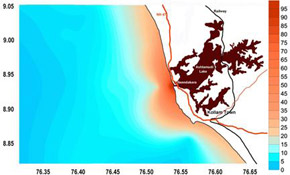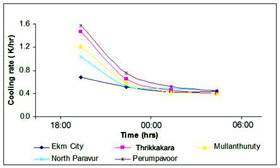
Atmospheric & Environmental Lab (AEL)
Greenhouse gases in coastal ocean, estuaries and other wetlands
Greenhouse gases affect climate on Earth through radiative forcing and modification of its energy balance. Carbon dioxide, methane and nitrous oxide are major greenhouse gases, in terms of their relative contribution to global warming. Wetlands and coastal regions play major roles in the global budget of methane and nitrous oxide, and coastal oceans are known to hold disproportionately large share of oceanic methane and nitrous oxide.

Distribution of dissolved Methane (nmol/l) in the coastal ocean (surface) off Neendakara during pre-monsoon season
Studies on the water to air fluxes of these gases as well as their dynamics in the coastal environment are being carried out. Natural and constructed wetlands, fresh water lakes and estuaries, forest swamps, coastal ocean, the role of aquatic vegetation on the transport of these gases from the wetland sediments to the atmosphere, etc., are covered under these studies. Estuaries and other wetlands in Kerala are under pressure from high population density and activities like coconut husk retting, tourism, etc., which influence the greenhouse gas production and emissions. The estuarine discharges to coastal ocean have been identified as a significant source of oceanic methane and nitrous oxide in the coastal regions.
These studies have shed light on the sources of these emissions as well as their temporal and spatial variations in this region. Water-to-air gas emission samples, water samples, and sediment samples are collected and brought to the laboratory for analysis. Methane is measured using FID and nitrous oxide using ECD on a gas chromatograph. Estuarine discharges are modeled using standard methodologies like LOICZ model.
Greenhouse gases in urban areas

Aquatic plants enhance methane transport from the wetland sediments to atmosphere.
The concentration of industries, automobiles, household emissions, municipal waste and sewage accumulation and processing, etc., make urban regions hotspots of greenhouse gas emissions. Carbon dioxide, methane, nitrous oxide, carbon monoxide, and a variety of industrial gases including halo-carbons, sulphur compounds, etc., fall under this category. The ground level concentration as well as vertical profile of methane in the urban centres in Kerala is being studied. Large number of grab samples are collected and analysed through gas chromatography to determine the GHG concentration in them. Spatial distribution within the urban area is derived from these. These studies show that these urban centres act as net greenhouse gas emitters.
Urban Heat Islands
Urbanization leads to micro-climate changes, particularly with regard to the thermal structure of the location. Urban Heat Island (UHI) the elevated air temperature observed within the urban centre compared to its rural surroundings, is the most significant among such changes. Factors leading to this elevation of temperature in towns are changes in the thermal characteristics of the surface, modification of the air flow patterns, reduction in evaporative cooling and heat added by human activities

Cooling rates observed at a few locations in Ernakulam region. Differeces in the night time cooling rates at urban and rural environments is the cause for Urban Heat Islands.
UHI can affect the residents through heat stress and associated health disorders, increased energy consumption for space cooling and refrigeration, etc. It is estimated that a 1oC elevation in air temperature in warm climates can increase the peak electricity demand by as much as 5%. Heat stress can precipitate cardiac problems in susceptible people. Studies on UHI are being carried out. Meteorological and physical parameters associated with the development of UHI are measured using equipment like sensitive air temperature and humidity recorders, infra-red thermometer, albedometer, soil moisture recorders, etc. These studies indicate the presence of moderate UHI of 1.4 to 3.8 oC in our cities, depending on the season, location, etc.




 RTI Act
RTI Act